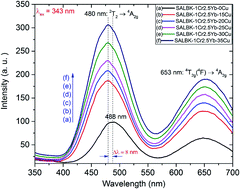Influences of copper–potassium ion exchange process on the optical bandgaps and spectroscopic properties of Cr3+/Yb3+ co-doped in lanthanum aluminosilicate glasses
Abstract
In this study, lanthanum aluminosilicate glasses with compositions of 45SiO2–20Al2O3–12.5LaF3–10BaF2–9K2O–1Cr2O3–2.5Yb2O3 (SALBK) were prepared using the conventional melting method and copper–potassium ion exchange process. Influences of the ion exchange process between copper and potassium on the visible, upconversion, and near-infrared luminescence spectra of Cr3+/Yb3+ co-doped under excitations of 343, 490, and 980 nm LD were investigated. The EDS analysis of SALBK glasses was measured to confirm the presence of atoms in the glasses. The values of direct and indirect bandgaps of Cr3+/Yb3+ co-doped SALBK glasses were calculated and analyzed. Besides, the energy exchange processes between Cu+, Cu2+ ions, and Cr3+, Yb3+ ions were also proposed and discussed.



 Please wait while we load your content...
Please wait while we load your content...